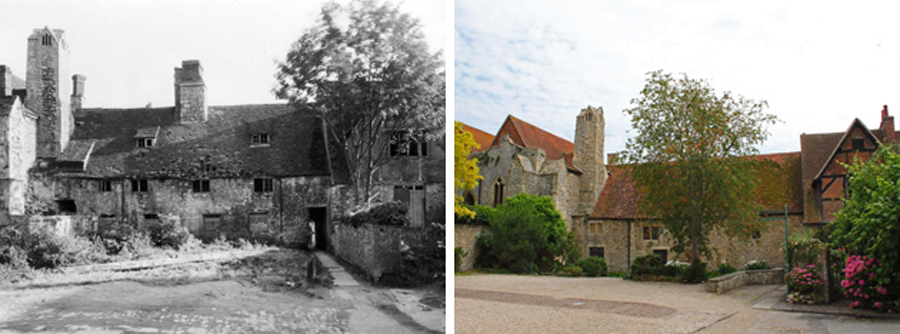The Early Years – Aquisition
The Friends of Abingdon (the Society) was formed in the 1940s with the express purpose of saving the medieval remains of the great Benedictine Abbey of Abingdon. Restoration and maintenance have been at the core of the Society’s work during the subsequent 75 years. The first task was to assemble the Buildings into a single ownership, as over many years the land had been divided into several plots with different purposes. In the twentieth century the Buildings had become home to about 30 families who were living in slum conditions, and a demolition order was proposed.
Local people including the standing MP, Abingdon Borough Council, architects, academics, and professional and trades people, realising the national significance of the Abbey Buildings, formed the Society to save the Buildings for future generations. An appeal was launched to generate funds to purchase and restore the ancient buildings. Click on the image of its cover page for a pdf of the appeal leaflet. An early contributor was the Pilgrim Trust, who provided a significant contribution of £3,000, and subsequent gifts from owners and supporters enabled the Society to bring the Buildings back into single ownership and commence restoration work.
Click on an image to view a larger version and the gallery, and the X to close the gallery
Eminent Members
The Society was fortunate to have some influential and eminent members on its founding Executive Committee. They included Walter H. Godfrey, a pioneer conservation architect and Director of the National Buildings Record, who led the restoration and maintenance work until his death in 1961. The early tasks were to make the Buildings weatherproof and secure, but progress was delayed by wartime regulations requiring licences to be obtained for materials and labour. However, the difficulties were overcome, work advanced and various internal walls which had been installed to enable residential occupation were removed to reveal the original spaces which were suitable for meetings and events. Restoration work continued through the subsequent decades; important roof work was carried out to the Checker Hall in 1956 and the Long Gallery in the early 1960s under the direction of Emil Godfrey, who continued his father’s work.
Click on an image to view a larger version and the gallery, and the X to close the gallery
Creation of the Unicorn Theatre
A significant development in 1953 was the conversion of the Checker Hall into the Unicorn Theatre. It was the vision of Alan Kitching, a local resident who was the Drama Advisor to Oxfordshire County Council, to create a miniature Elizabethan theatre. The Unicorn was launched with a sequence of Handel operas which attracted widespread interest and press coverage. Local drama and music clubs now had a theatre on which to stage their productions and this beautiful 92 seat theatre with excellent acoustics has been busy ever since.
Click on an image to view a larger version and the gallery, and the X to close the gallery
National and Local Importance
The national heritage significance of the Buildings is recognised in their listing by Historic England as a scheduled monument and architecturally Grade 1. The local importance is that over 75 years the Buildings have become a vital community asset, and continued repair and maintenance have enabled the provision of a wide range of atmospheric spaces for events of all kinds to be hosted and enjoyed.

Ongoing Maintenance
The routine maintenance of keeping the Abbey Buildings tidy, clean, and presentable, both internally and externally as a civic asset, is the responsibility of our curator. The gardens are maintained by a part-time professional gardener and a team of volunteers.
Maintenance and repair of the fabric of the buildings is an ongoing concern, requiring regular inspection to identify the need for immediate repair and medium- or longer-term works, which often have to be approved by a supervising officer from Historic England. Examples of work undertaken in recent years include replacement of steps, roof and joinery repairs, installation of a new guttering and rainwater system, and clearance of grasses from the top of the Checker chimney.











